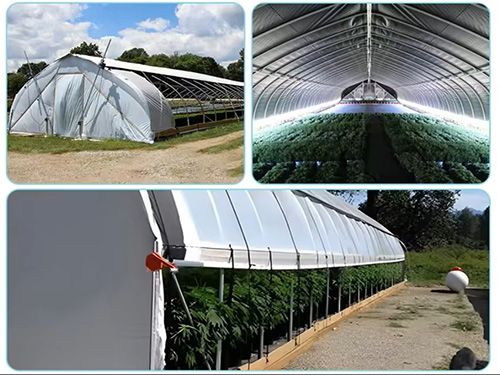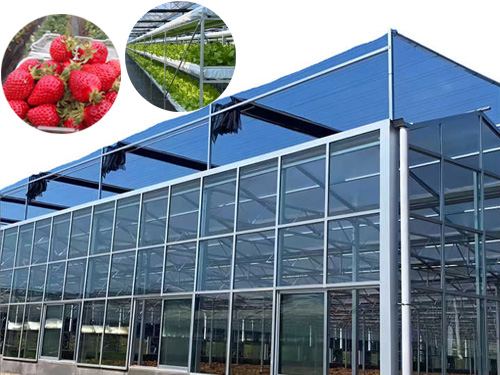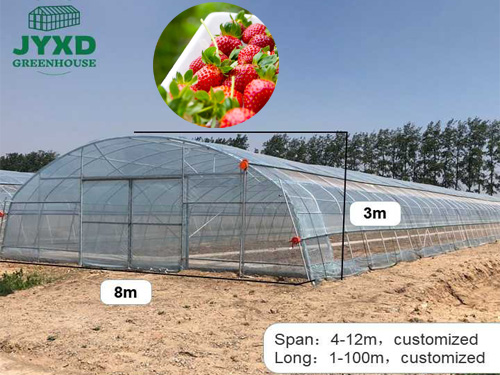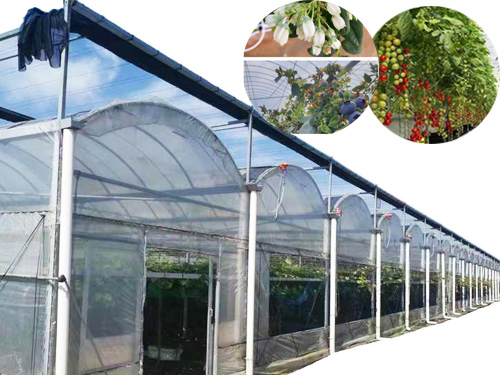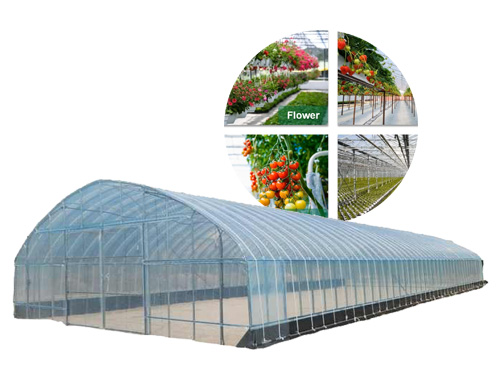NEWS DETAILS
NEWS INFORMATION
How to Manage Water Quality in Greenhouses: Cleaning and Maintenance Solutions
AUTHOR:jyxd-greenhouse DATE:2025-03-12 16:26:04 HITS:79
Water quality is one of the most important factors in greenhouse farming, as it directly affects plant health and productivity. In greenhouses, water is essential for irrigation, hydroponic systems, and cooling systems, making it critical to ensure that the water used is clean and free of harmful contaminants. Poor water quality can lead to plant diseases, nutrient imbalances, and reduced crop yields. This article provides an in-depth guide on how to manage water quality in greenhouses through cleaning and maintenance solutions, ensuring optimal growing conditions for your crops.
1. Importance of Water Quality in Greenhouses
In greenhouse environments, water quality is essential for several reasons:
• Plant Health: Clean water is necessary for optimal plant growth. Contaminants in water, such as salts, pathogens, or excess minerals, can harm plants, disrupt nutrient uptake, and cause diseases.
• Nutrient Delivery: Water is the carrier of nutrients in both soil-based and hydroponic systems. Impure water can hinder nutrient absorption, leading to nutrient deficiencies or toxicities in plants.
• System Efficiency: Poor water quality can damage irrigation systems, clogging pipes, emitters, and filters. Regular water maintenance ensures that systems operate efficiently and effectively.
• Disease Prevention: Contaminated water can spread diseases such as root rot or fungal infections. Ensuring water is clean helps protect crops from harmful pathogens.
2. Key Factors Affecting Water Quality in Greenhouses
Several factors influence the quality of water in greenhouse systems, and understanding them is crucial for effective management:
• Water Source: The quality of water from external sources, such as wells, rivers, or municipal supplies, can vary greatly. It’s important to test the water regularly for pH, hardness, and contamination levels.
• pH Levels: Water pH plays a significant role in nutrient availability. If the water is too acidic or alkaline, it can prevent plants from absorbing nutrients properly. Maintaining the optimal pH level is crucial for healthy plant growth.
• Water Hardness: Hard water, which contains high levels of calcium and magnesium, can lead to mineral buildup in pipes and irrigation systems. It can also affect nutrient uptake in plants, especially in hydroponic systems.
• Salinity: High salt content in water can lead to salt accumulation in the growing medium or hydroponic system, which may negatively affect plant health and growth. Managing water salinity is especially important in areas with salty water sources.
• Contaminants and Pathogens: Pathogens, algae, and other microorganisms can contaminate greenhouse water sources, leading to plant diseases or clogging irrigation systems.
3. Cleaning and Maintenance Solutions for Greenhouse Water Systems
To ensure optimal water quality, regular cleaning and maintenance of water systems are essential. Here are key solutions for managing water quality effectively:
3.1 Regular Water Testing
Frequent water testing is essential for identifying potential water quality issues before they affect plants. Key tests to conduct regularly include:
• pH Testing: Measure the water’s pH regularly to ensure it is within the optimal range for plant growth (typically between 5.5 and 6.5 for most plants). Adjust the pH if necessary using pH adjusters.
• EC (Electrical Conductivity) Testing: This test measures the level of dissolved salts and nutrients in the water. Monitoring EC helps ensure that plants are receiving the correct nutrient balance.
• Hardness Testing: Measure the hardness of water to determine if mineral buildup is occurring. If hardness is high, consider using water softeners or alternative water sources.
• Pathogen Testing: Regularly test for harmful pathogens like bacteria or fungi that can affect water quality and plant health. You can use water treatment methods to eliminate these pathogens.
3.2 Filtration Systems
A high-quality filtration system is crucial for removing physical debris, pathogens, and excess minerals from the water. Different filtration methods include:
• Mechanical Filters: These filters remove physical particles such as dirt, sand, and debris that can clog irrigation systems or affect water quality. Sand filters, mesh filters, and disc filters are commonly used in greenhouse water systems.
• Carbon Filters: Activated carbon filters are effective at removing chlorine, chloramine, and organic compounds that can harm plants or alter water quality.
• UV Filtration: Ultraviolet (UV) light systems are an excellent way to disinfect water and kill harmful microorganisms, preventing the spread of diseases like root rot.
• Reverse Osmosis (RO) Systems: RO systems can remove up to 90% of impurities in water, including salts, minerals, and contaminants. While this system is more expensive, it is especially beneficial for areas with poor water quality.
3.3 Water Softening and Desalination
If your water source is particularly hard or saline, water softeners or desalination methods can be employed to improve water quality:
• Water Softeners: These systems replace calcium and magnesium ions with sodium ions, reducing water hardness. They are particularly useful in hydroponic systems where mineral buildup can interfere with plant nutrient uptake.
• Desalination Systems: For areas with saline water sources, desalination removes salts from water, ensuring that water quality remains optimal for plant health.
3.4 Algae Prevention and Treatment
Algae growth in water systems can lead to clogging, contamination, and reduced water quality. To prevent and control algae growth:
• Shade the Water Reservoir: Keeping the water reservoir covered or shaded helps prevent light from reaching the water, reducing the potential for algae growth.
• Use Algaecides: If algae growth is detected, using algaecides or hydrogen peroxide can help control the issue without harming plants.
• Clean the Reservoir Regularly: Periodically drain and clean water reservoirs to remove any algae buildup or organic matter that could promote growth.
3.5 Draining and Flushing Systems
Over time, water systems can accumulate salts, minerals, and other residues. Regularly draining and flushing the system can help maintain water quality:
• Flush Irrigation Lines: Periodically flush out irrigation lines with clean water to remove mineral buildup or debris.
• Clean Nutrient Reservoirs: In hydroponic systems, it’s essential to clean nutrient reservoirs every few weeks to prevent the accumulation of old nutrients, salts, or algae.
• Drain the System Before Seasonal Changes: Before shutting down the system for seasonal maintenance or when transitioning to a new crop, drain and clean the water system to prevent contamination.
4. Best Practices for Long-Term Water Quality Management
To maintain high water quality over the long term, follow these best practices:
• Monitor Water Sources: Ensure that the water source remains consistent in quality. If using municipal water, check for chlorine or other chemicals that may need to be filtered.
• Use Clean Containers and Equipment: Always use clean, food-grade materials for storing and transporting water to avoid contamination.
• Optimize Water Recycling: In hydroponic systems, optimize the recycling of water to reduce waste and maintain consistent nutrient levels.
• Maintain System Components: Regularly inspect and maintain pumps, pipes, and filters to ensure they are functioning properly and that water remains clean and free-flowing.
5. Conclusion
Managing water quality in greenhouses is essential for maintaining plant health, optimizing nutrient delivery, and preventing diseases. By implementing effective cleaning and maintenance solutions, such as water testing, filtration systems, and regular flushing, greenhouse operators can ensure that their water supply remains clean and free from contaminants. Taking proactive steps to manage water quality will lead to healthier plants, higher yields, and more efficient greenhouse operations.
If you’re looking for professional solutions for managing water quality in your greenhouse, feel free to contact us. Our team can help you choose the best water treatment options for your specific needs.
Hebei Juyou Xinda Greenhouse Facilities Co.,Ltd.
Copyright © 2024-2025 https://www.jyxd-greenhouse.com. All Rights Reserved Hebei Juyou Xinda Greenhouse Facilities Co.,Ltd.Copyright





 Current Location:
Current Location:


